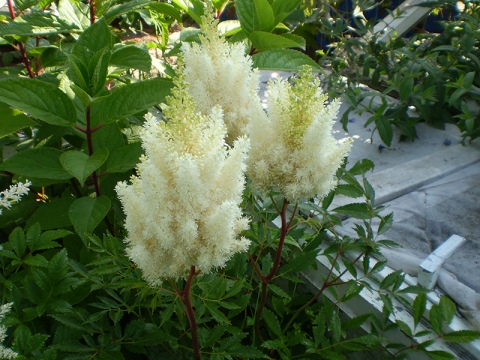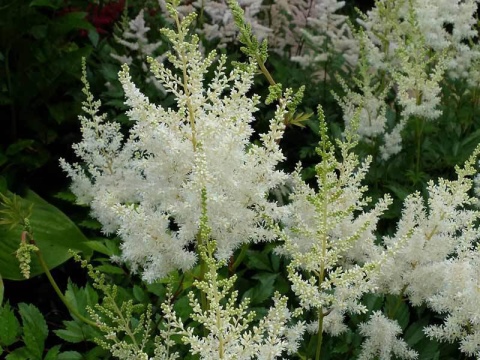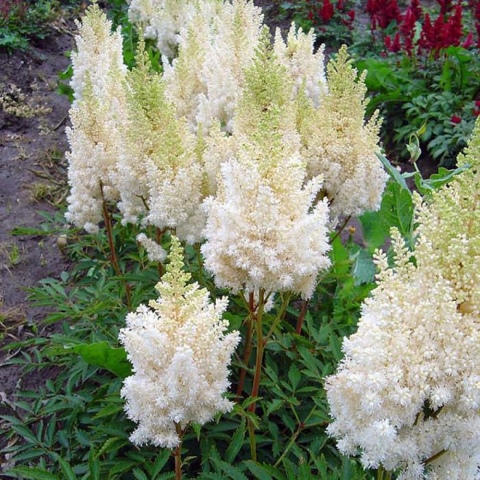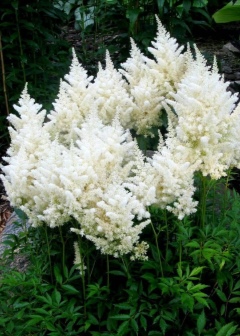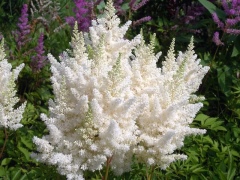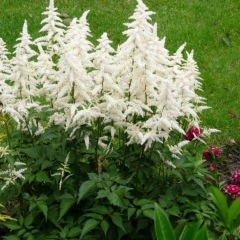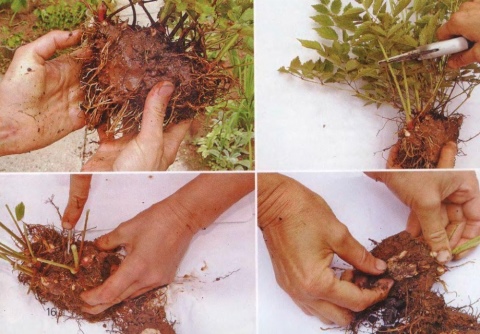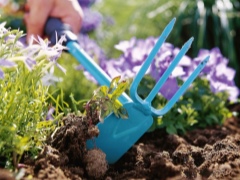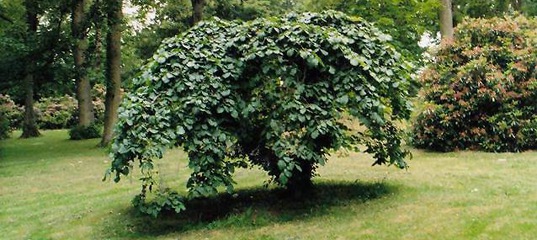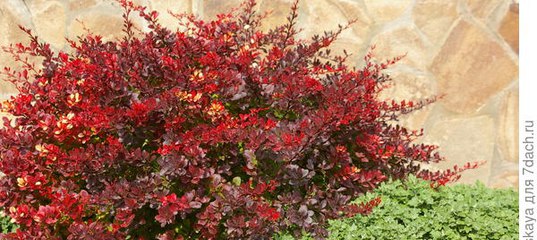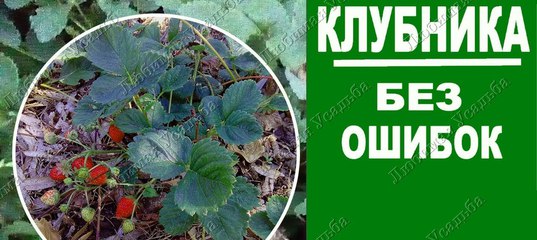Choosing a place for planting astilba
Choosing the right place and time for planting will guarantee that astilba will quickly take root. The growth rate depends on the presence of heat and moisture.
Astilbe does not need a lot of light to grow quickly. Best of all, she feels in a rarefied shadow. In such conditions, flowering will be long and abundant. Although varieties with white and light pink flowers (Weiss Pearl, Gloria, Bergkrisstal and others) feel great in the sun. Flowering in this case is shorter, but twice as intense.
When choosing a planting site, take into account the time at which this or that type of astilbe blooms. For example, mid-flowering (July) specimens prefer shaded corners, late and early varieties bloom for a long time both in the sun and in the shade. Astilba grows well in any soil, but if you want to achieve long flowering, then places with high groundwater will be the best conditions for achieving the cherished goal. The plant may not tolerate long-term drought
The amount of potassium and phosphorus in the top layer of the earth is very important. In the propagation beds (1 meter long), you can pour complex fertilizers (30 grams) and bone meal (2 handfuls)
When planting in a flower garden, small pits are dug (no more than 30 cm deep), the aforementioned fertilizers and flour are poured into them, and humus is added. Mixed and filled with water. Delenki (parts of the rhizome with buds) are covered with mulch (3 cm).
Care
Astilba is an unpretentious plant, only watering and feeding require special attention. Excessive dryness of the soil can lead to the death of the flower, so watering should be moderate, but regular. It is also recommended to periodically loosen the soil, weed and remove dry inflorescences. During the summer, you need to make three mineral dressings at intervals of a month.
The main feature of astilba is that buds appear on the upper part of the rhizome every season. The annual growth of the trunk is from 3 to 5 cm, while the lower part dies off. Because of this, astilbe needs mulching. It will serve as a thermal protection for the plant in winter, maintain sufficient moisture and softness of the soil, and prevent the germination of weeds. As mulch, you can use needles, dry grass, peat and compost mass.

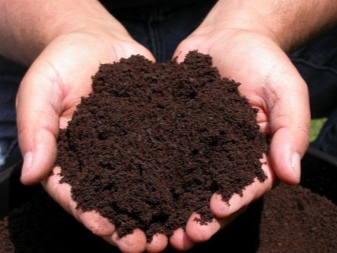
Astilba is propagated by dividing the bush. This procedure can be carried out no more than 1 time in 5-6 years.
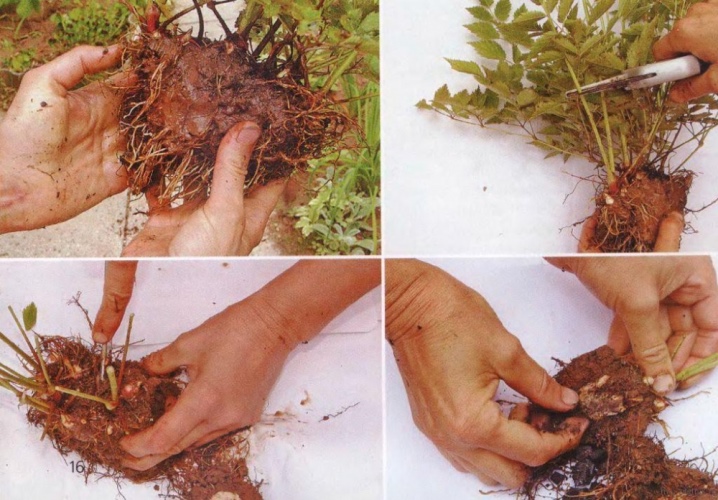
Regularity of watering
One of the prerequisites for good growth and lush flowering of astilba is regular watering. The plant is unable to withstand prolonged drought. Experienced gardeners recommend always keeping the soil moist near the bush. In its natural environment, it is often found in wetlands. Planted in a sunny area "Weiss Gloria" in the hot season should be watered twice a day. If astilba grows in shade or partial shade, the gardener should maintain moderate moisture in the soil and prevent it from completely drying out. In this case, the irrigation schedule is set taking into account weather conditions.
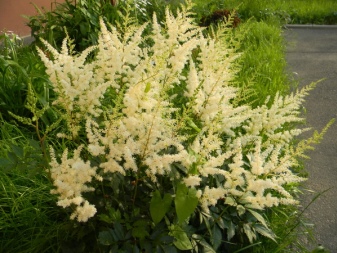

Plant feeding
To ensure lush bloom, Weiss Gloria should be fertilized regularly. In the spring (at the very beginning of the growing season), it is recommended to apply fertilizers with a high nitrogen content. This helps ensure green mass build-up.
The rest of the time, astilba is fed with phosphorus-potassium fertilizers. One top dressing is carried out right before the beginning of flowering, and the second - directly during. In addition, you can fertilize the plant in the fall, before preparing it for winter.
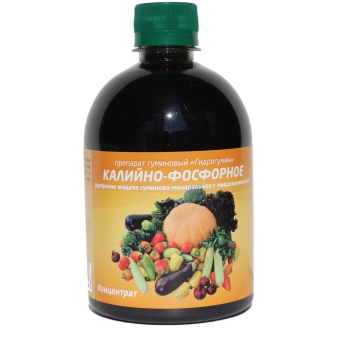
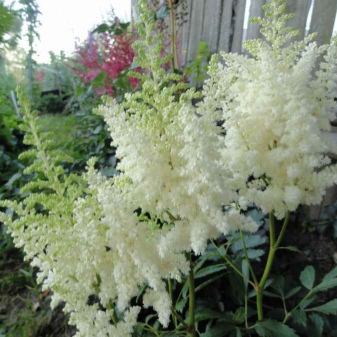
Bush crown formation
One of the advantages of astilba is that the plant is able to form a crown itself, without outside help. The gardener only needs to periodically carry out sanitary cleaning, removing dried shoots, leaves and wilted peduncles.
Pruning involves several steps:
- after the end of flowering, peduncles are removed;
- complete pruning of shoots in the fall is carried out after the arrival of frost.
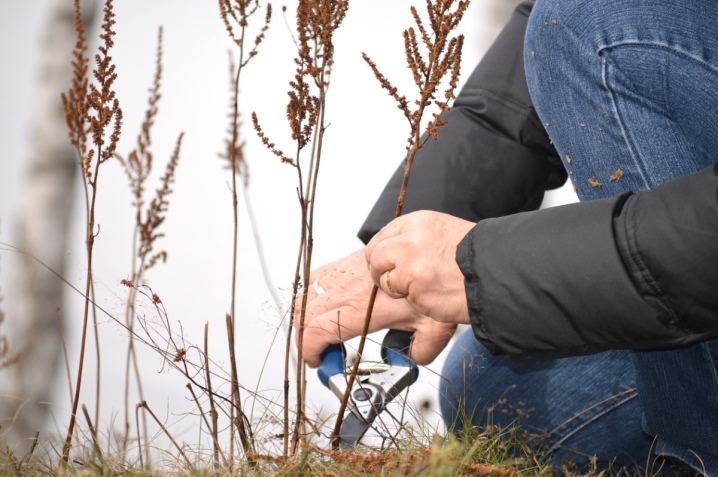
Protection against insects and diseases
Astilba is quite resistant to diseases and all kinds of pests. In rare cases, "Weiss gloria" can be affected by strawberry and rootworm nematodes. This is a rare but dangerous pest that is difficult to control. In practice, such drugs as "Nurell D" and "Nematofagin" have proven their effectiveness. Before proceeding with the treatment, it is necessary to remove the parts of the plant affected by the pest.
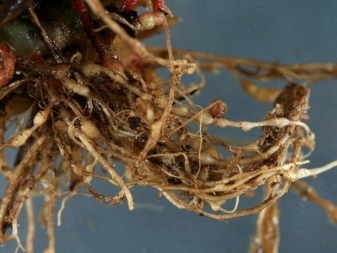
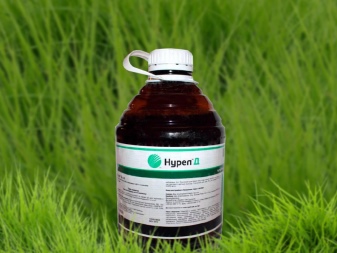
Sometimes astilba is struck by a drooling penny. To eliminate this problem, you need to treat the plant 2-3 times with insecticides, for example, the drug "Inta-vir". Excessively high humidity attracts slugs. To control these pests, beer traps are used or collected by hand.
Humidity combined with cool weather can cause root rot to attack astilba. It is most dangerous for young plants, which often leads to their death. As a control, the following measures are applied: removing the affected roots and soaking the remaining roots in a fungicide solution. You can use "Fundazol".
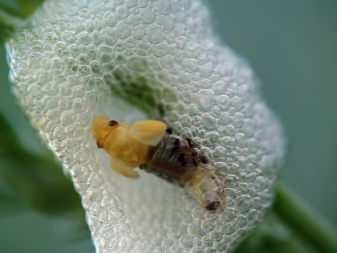
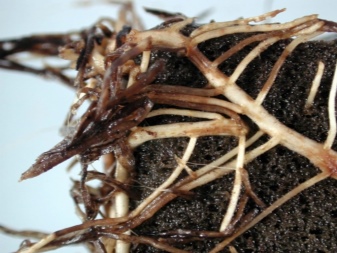
Astilba Arends
This hybrid astilbe (most hybrids are derived from Chinese astilba) grows up to 1 m in height. The plant has a powerful and branched rhizome. The shape of the bush is spreading, pyramidal or spherical. Leaves are compound, pinnate, with jagged edges. Flowering occurs in July-August and lasts up to 40 days. These astilbes are ideal for cutting.
Amethyst
Height plants - up to 80 cm... Astilba leaves are yellowish green, matte. Narrow and dense paniculate inflorescences (up to 30 cm long) of a delicate lilac color bloom in July and do not fade for up to 30 days.
Brautschleier, Bridalveil
This plant (up to 80 cm high) has attractive brownish-green leaves and loose, drooping yellowish-white inflorescences 30 cm long. Flowers bloom in the first half of July.
Fanal
This astilba looks good on a flower bed, in beddings, mixborders. Also suitable for cutting. Reddish stems and petioles are harmoniously combined with dark green glossy leaves and narrow crimson-red panicle inflorescences that bloom in July.
White Gloria, Weisse Gloria
Plant height - up to 80 cm. Leaves - dark green, shiny. Inflorescences are dense, diamond-shaped, white, up to 25 cm long.
Color Flash
This medium-sized astilbe (up to 65 cm high) is primarily notable for its unique leaves that change color. In the spring they are bright green, in the summer they gradually, starting from the edges, turn red and purple. Inflorescences are narrow, pale pink panicles. They bloom in early August.
Color Flash Lime
This plant differs from the previous one only in the color of the leaves. In spring it is lemon with a purple edging, in summer it gradually darkens and becomes greenish, and closer to autumn, the leaves in the center become creamy, and at the edges - dark green. Against the background of bright leaves, lilac inflorescences look great.
Erica (Erika, Erica)
The stems of the plant reach a height of 90 cm. This astilbe is attractive not only for its light pink rhombic inflorescences, but also for its reddish-brown leaves.
How is America different from other hybrids?
We recommend that you familiarize yourself
Astilba, species of which grow in the wild nature of Asia and North America, has a height of 50 cm to 2 m and a variety of colors from light pink to maroon shades.During the warm season, the aboveground part of any crop variety forms a large bush blooming with bright paniculate inflorescences of different lengths. With the onset of cold weather, the stem dies off, in the spring new bushes form from the root, expelling erect stems from the buds. Astilbes love moist soil and grow well near artificially created bodies of water.

Astilba America is a compact plant. Its height reaches 70 cm. It has panicles of light, pink-purple hues. Its buds, collected in diamond-shaped inflorescences, begin to bloom in early July. This process in America is short-lived. It ends by the end of July. The plant then forms seed pods. Astilba is very prolific. There are up to 2 thousand seeds in 1 g, but it makes no sense to collect them, because they do not inherit the genetic characteristics of the hybrid.
Astilba Arends America is good because it looks great in semi-shady places where diffused sunlight falls. It is used in group plantings near hedges or fruit and berry bushes. Its delicate leaves and elongated panicles of flowers look good in the central part of the mixborder. Plants are often planted in clusters to create a solid, bright spot against a dark green conifer plantation. Astilba America can be used to decorate:
- borders;
- shores of artificial reservoirs;
- various compositions;
- flower beds of perennial plants;
- heavily shaded areas.
All types of astilba are used as honey plants. Their bright flowers, exuding a sweet scent, attract bees and other insects that collect nectar and pollen.
It is combined with all perennials in the flower bed.
When purchasing this variety, you need to choose plants for her that are well suited to Astilba America in size and color. Then it will harmoniously blend with its neighbors.
Astilba America is organically combined with many crops growing in partial shade conditions. Its short stature allows other plants to receive sunlight. Its delicate bushes look beautiful against the background of round-leaved bergenia, lilies of the valley, long iris leaves. Podophyllum and hellebore look organically next to this plant.

